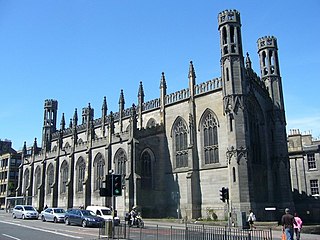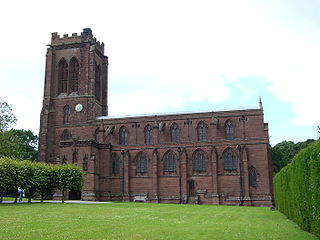History
St James's was originally founded by Rev. Edward Craig, to relieve the overcrowding at St Paul's Church (now Old St Paul's), and initially occupied a building of 1829 in Broughton Place, Edinburgh. In 1883 this building was sold, and the congregation moved to the present site (feued from the Fettes Trust), at first erecting a hall, while conducting a competition for the new church, which was won by Robert Rowand Anderson in 1885. The church was built by John Beattie and Son in red Corsehill stone. In 1888 the church was opened by the Bishop of Edinburgh, but it could not be consecrated until 1894, when it was free of debt. The main entrance to the church was originally up an alleyway at the side (still used for access to the church hall) leading via the baptistery to the west end of the nave.
In 1894 the Vestry voted to accept a generous offer from the distinguished artist William Hole (a member of the congregation) to create a complete painted decoration scheme, in his spare time and at no cost.
In 1898 alterations were made to the chancel, in accordance with a scheme designed by Sir John James Burnet, including a gilded triptych above the altar with paintings by William Hole.
In 1922 a rood was erected on a beam across the chancel arch, as a memorial to a former rector. It was designed by Sir John James Burnet and excuted by the sculptor Gilbert Bayes. It was later thought that the rood detracted from the view of the chancel, and it was removed and the five sculpted figures installed in the entrance vestibule.
In 1923 a baptistery, also designed by Sir John James Burnet, was added at the west end of the south aisle and now became the way for the congregation to enter the church, through a traceried screen.
In 1985 major structural problems were detected, which led to a progamme of remedial work. including the creation of a new entrance through what had been the Rector's vestry, giving a better entrance from the street and leading directly to the south aisle.
St Philip's
In 1895 a mission congregation was established at Canonmills. In 1909 this congregation built a new church, St Philip's, and the joint charge was renamed "St Philip’s and St James’". St Philip's Church is now rented to another religious body. [11] A "Jesse Tree" carving, by Tom Whalen, was commissioned in 1948 and installed in St Philip's. It is now in St James's church hall.
Christ Church
Christ Church, in the nearby Trinity district, was built in 1854, initially as a private chapel. In 1875 its owner sold it to its congregation. In 1971 Christ Church was linked with St James's under a single rector. but problems with the fabric meant that it became uneconomic to repair: Christ Church was closed in 1980 and is now a private house, "Church House", 118 Trinity Road. [14] Following the closure, a Christ Church chapel was created at St James's in a former cloakroom, containing some of the artefacts familiar to members of the Christ Church congregation.
Description
The church occupies a narrow site with the east end facing Inverleith Row: It contains a chancel, a three-bay nave with south aisle, and a short tower. There was provision for extending the nave by two further bays, and for increasing the height of the tower, but this did not happen.
The interior decoration includes a frieze with the words of the Te Deum with vines, peacocks, and apostles, prophets and martyrs, created in spirit fresco by William Hole, who also painted the triptych of Christ with St George and St Stephen above the altar. The chancel decoration, including the altar, choir stalls, and paving, is by John James Burnet, with windows depicting the Good Samaritan by Henry Payne of Amberley, described as "two lights with intricate, graceful drawing."
The baptistery at the west end contains a marble font by Charles d'Orville Pilkington Jackson and windows by Douglas Strachan.
Peace Garden
On Sunday 12 November 2023 the Bishop of Edinburgh blessed a Peace Garden in front of the church, incorporating a Peace Pole. [19] The garden symbolises hope and healing, and is intended to be a place for people to sit and rest. [20]

St Giles' Cathedral, or the High Kirk of Edinburgh, is a parish church of the Church of Scotland in the Old Town of Edinburgh. The current building was begun in the 14th century and extended until the early 16th century; significant alterations were undertaken in the 19th and 20th centuries, including the addition of the Thistle Chapel. St Giles' is closely associated with many events and figures in Scottish history, including John Knox, who served as the church's minister after the Scottish Reformation.

St Mary's, Harrow on the Hill, is the Borough and Parish Church at Harrow on the Hill in northwest London, England. It is a Grade I-listed building.

Goldenacre is an area in Edinburgh, Scotland, centred on the northern end of Inverleith Row. It lies on and to the south of Ferry Road, which forms the effective boundary with Trinity. It is part of the Inverleith Conservation area and the Stockbridge and Inverleith Community Council area.

Trinity is a district in northern Edinburgh, Scotland, formerly part of the burgh of Leith. It is one of Edinburgh's outer villa suburbs, mainly developed in the 19th century. It is bordered by Wardie to the west and north-west, Newhaven to the north-east, Victoria Park and Bangholm to the east and Goldenacre to the south.

St Paul's and St George's Church is an evangelical church of the Scottish Episcopal Church in central Edinburgh, Scotland. It is located on the corner of Broughton Street and York Place in the east end of Edinburgh's New Town, and is protected as a category A listed building.

St. Michael's Church is an Anglican church in Brighton, England, dating from the mid-Victorian era. Located on Victoria Road in the Montpelier area, to the east of Montpelier Road, it is one of the largest churches in the city of Brighton and Hove. The church is a Grade I listed building.

St Mary's Church is in the village of Eccleston, Cheshire, England, on the estate of the Duke of Westminster south of Chester. The church is recorded in the National Heritage List for England as a designated Grade I listed building. It is an active Anglican parish church in the diocese of Chester, the archdeaconry of Chester and the deanery of Chester. Its benefice is combined with that of St Mary, Pulford. The Dukes of Westminster are buried in the adjacent Old Churchyard.

The Parish Church of St Cuthbert is a parish church of the Church of Scotland in central Edinburgh. Probably founded in the 7th century, the church once covered an extensive parish around the burgh of Edinburgh. The church's current building was designed by Hippolyte Blanc and completed in 1894.

St. Mary's Church, Broadwater, is a Church of England parish church in the Worthing Deanery of the Diocese of Chichester. It serves the ecclesiastical parish of Broadwater, West Sussex and is named after St. Mary. St Mary's is one of several sites in this benefice along with Queen Street and St. Stephen's.

St Mary the Virgin, Acocks Green is a Grade II listed Church of England parish church in Acocks Green, Birmingham, England.

Saint Mary's Church, is the civic church for the city of Southampton, Hampshire, England. Originally founded in circa 634, St Mary's has been the mother church of Southampton since its inception. The present building, now the sixth incarnation of a church on this site, dates mostly to a rebuilding from 1954 to 1956, following its destruction in the Southampton Blitz, except for the notable Grade II listed tower and spire, which date from 1912 to 1914.

The Parish Church of St Peter, Great Berkhamsted, is a Church of England, Grade II* listed church in the town of Berkhamsted, Hertfordshire, in the United Kingdom. It stands on the main High Street of the town and is recognisable by its 85-foot (26 m) clock tower.

St Andrew's Church is in Colne Road, Burnley, Lancashire, England. It is an active Anglican parish church in the deanery of Burnley, the archdeaconry of Blackburn, and the diocese of Blackburn. Its benefice is united with those of St Margaret, Burnley, and St James, Burnley. The church is recorded in the National Heritage List for England as a designated Grade II listed building.

All Saints' Church, Winthorpe is a Grade II listed parish church in the Church of England in Winthorpe, Nottinghamshire, England. The current building, the construction of which was completed in 1888, is at least the third version of the church, which dates back to at least the early 13th century. All Saints' Church was commissioned by the church rector, Edward Handley, in memory of one of his relatives.

St Margaret's Church is a Category B listed church of the Scottish Episcopal Church at 355 Kilmarnock Road, Newlands, Glasgow, Scotland.

St Mary's Church is a heritage-listed Roman Catholic church at 20 Merivale Street, South Brisbane, Queensland, Australia. It was designed by Simkin and Ibler and built from 1892 to 1929. It was added to the Queensland Heritage Register on 3 December 2004.

St Michael and All Angels Church is a heritage-listed Anglican church at 2-6 Alford Street, Kingaroy, South Burnett Region, Queensland, Australia. It was designed by Colin Deighton and built in 1911. It was added to the Queensland Heritage Register on 17 September 2010.

St Peter's Church is a Catholic church in Woolwich, South East London. It is situated between Woolwich New Road and Brookhill Road, the main entrance being on Woolwich New Road. The church was designed by Augustus Pugin in 1841–42 in the style of the Gothic Revival and is one of only three Pugin churches in London. Pugin's design remained unfinished as the projected tower and spire were never built. The parish of St Peter the Apostle serves the Catholic community of central Woolwich and surrounding areas, and is part of the Archdiocese of Southwark which is in the Province of Southwark.

The Parish Church of St Mary with St Edward and St Luke, Leyton, also known as Leyton Parish Church and formerly, St Mary the Virgin, Leyton, is a Church of England parish church in Leyton, East London. Although records of the church go back to about 1200, it has been repeatedly rebuilt; the oldest surviving fabric dates to 1658, but a majority of it is from the early 19th century. It is a Grade II* listed building.

West St Giles' Parish Church was a parish church of the Church of Scotland and a burgh church of Edinburgh, Scotland. Occupying the Haddo's Hole division of St Giles' from 1699, the church was then based in Marchmont between 1883 and its closure in 1972.





















